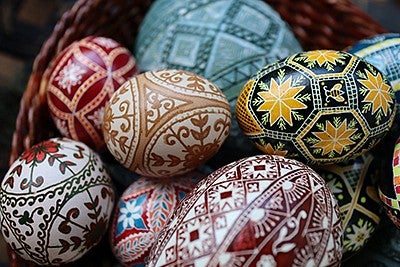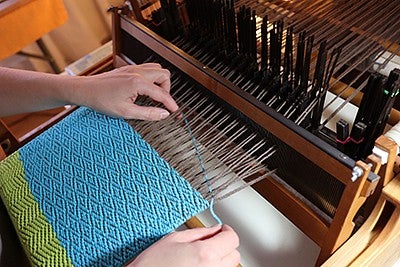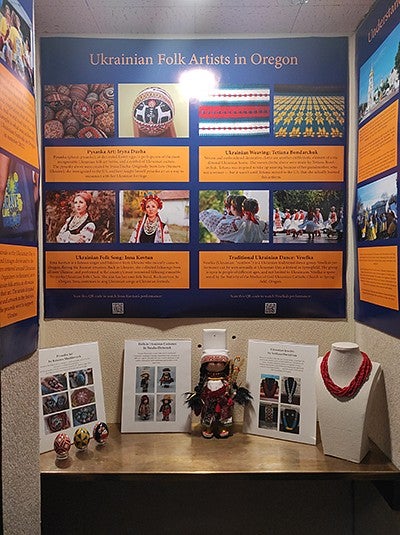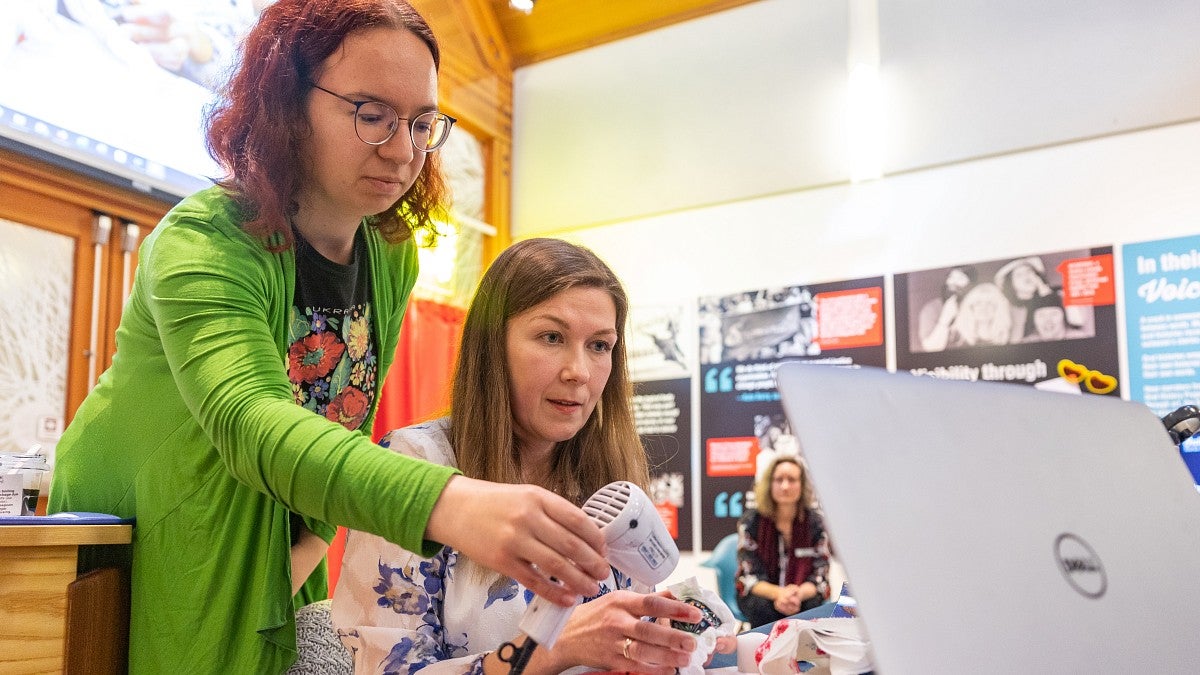Iryna Stavynska, a Fulbright scholar from Ukraine, is bringing some of the art and culture of her country to the UO as she makes one last stop on an educational journey that will soon take her back to her war-torn homeland.
Stavynska received her bachelor’s degree in Japanese from Kyiv National Linguistic University and then studied in Japan, where she became interested in mythology and Oregon’s folklore program. She is working with Oregon Folklife Network, the Department of Folklore in the College of Arts and Sciences, the School of Music and Dance, the Museum of Natural and Cultural History, and the Jordan Schnitzer Museum of Art to highlight the art and culture of Oregon’s vibrant Ukrainian community.
“I was looking at programs all over the globe and I found this one and it just seemed like such a perfect place for me, so many interesting classes on fairytales and medieval magic and urban legends,” she said.
She applied for a Fulbright, a scholarship that encourages students to improve intercultural relations, cultural diplomacy between countries, and got it.

“I was very lucky, and they agreed to send me to the university,” she said. “I am grateful for this program and how understanding everyone is and so respectful of my heritage and culture. The folklore department is a safe place for me to speak Ukrainian and talk about Ukraine.”
Through her work, Stavynska curated “Amplifying Ukrainian Voices,” a Tiny Galleries exhibition at Knight Library that showcases work and stories of Ukrainian folk artists in Oregon and Ukraine’s rich heritage, with a focus on the strength and courage of Ukrainians in their current fight for freedom and independence.
She also has been instrumental in bringing Ukrainian artists together for a number of campus events, including a presentation in March on pysanka, the Ukrainian art of egg decorating, and an event on April 8 featuring Ukrainian weaving presented by Tetyana Horner, a traditional weaver originally from Kakhovka in southern Ukraine.
Later in April, the Jordan Schnitzer Museum of Art will host two additional artists for programs: Marina Malyarenko’s April 15 talk on the art of Petrykivka, a traditional Ukranian style used in household decoration, and Sashko Danylenko’s “The Superheroes Among Us” illustration series on April 23 .
“I’ve lived two years here and I didn’t realize there were other Ukrainians because we don’t have Ukranian classes,” she said. “We have Russian classes. We didn’t have Ukrainian events where people would come.
“As I’m doing events, I’m discovering more people. Five other people are Ukrainian on campus. I’ve learned there is a community of Ukraine refugees in Eugene. They have been coming to our events too.”

The artists also are activists focused on Ukrainian resistance. One of them, Sashko Danylenko, is famous for depicting ordinary Ukrainians doing ordinary things during the war.
“There’s so much focus on political leaders, but what really makes the Ukrainian resistance so successful is so many people are doing what they can without fear,” Stavynska said.
For Stavynska, who will graduate in June with a master’s degree in folklore and public culture, the events and Russia’s invasion have increased awareness of Ukrainian art and culture, something that she says Russia has systematically tried to erase.
“People here don’t feel like they can do anything, but there are some small ways to help,” she said. “One of them is as simple as supporting Ukrainian events and Ukrainian-led programs, because for so long because of Russian imperialism there is a lack of Ukrainian representation, achieved by their domination and appropriation of the Ukrainian artist and other countries that they colonized.”
“The effort of learning more about Ukraine, even if it’s only something as simple as weaving, you learn about the history of Ukrainian resistance and art. The more we have spaces to do this and talk about this, the more Ukrainians will feel safe here.”

In Ukraine it’s alarming. When Russia invaded Mariupol, they burned rare Ukrainian books and replaced them with books by Russian authors.
“In the occupied territories they gave them Russian textbooks, and if you seem Ukrainian in any way you can face torture and death now,” she said. “And so it is a very real thing.”
In Kyiv, she said the focus now is primarily on shelling infrastructure. A recent attack destroyed a building that controls heat in the neighborhood where Stavynska’s mother lives.
“They don’t have any heat right now and it’s still winter in Ukraine, and there’s also always the chance that the missile will hit your house,” she said.
On campus, people can help by supporting Ukrainian artists and activists and attending their events and by giving to the nonprofit Ukrainian Foundation based in Beaverton. The foundation supports refugees and actively supports the resistance.
“If someone wants to help it’s a great starting place and it’s very important to us to be heard and be seen,” she said.
After graduation, Stavynska plans to return home to Kyiv.
“While I’m here I want to support the Ukrainian culture,” she said. “It’s a very important moment for Ukraine and culture, but I feel like I want to be in Ukraine. When you go to Ukraine you see so much bravery. You feel like you are surrounded by people who are doing amazing things. There’s been so much response and so much kindness, even with the war. It just seems like the place to be for me.”
—By Sharleen Nelson, University Communications
—Main image: Iryna Stavynska (standing) helps with egg decorating (Photo by Molly McPherson, courtesy of The Daily Emerald)


